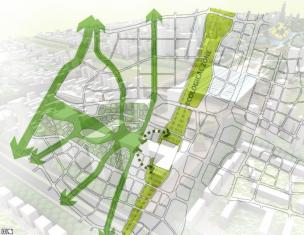The Mitsubishi ACX and the Skoda Yeti have one thing in common - they found themselves behind a number of other compact crossovers that were released to the market much earlier. Before the release of two representatives of the popular class, such models as the Nissan Qashqai (Nissan Qashqai), Honda CR-V(Honda CRV) and Toyota RAV4 (Toyota Rav4). Can the youngsters achieve success and overtake the luminaries, and which of them has a better chance of a comfortable life in the automotive arena?
This crossover deserves attention if only for the fact that it turned out to be the first all-terrain vehicle (albeit a compact one) in the history of the Czech brand. Let's close our eyes to the successes of its older brother - Volkswagen. Everything about the Skoda Yeti is good, but there is a fly in the ointment. The slightly toy-like but friendly appearance of the Czech car requires self-sufficiency from the Russian client: he should not think about questions like: “What will the neighbors in the Pajer think about me, won’t they laugh?” Hence the unimpressive sales results - against 19 thousand Mitsubishi ACX, only 8 thousand for the Skoda Yeti.


The Japanese cost little money when creating the SUV. In fact, they were very lucky: they had a copy on hand ready for cosmetic surgery - a Mitsubishi Outlander XL. And the appearance of the Mitsubishi ASX was designed to suit the unisex style - both yours and ours, that is, it will suit both men and women. Aggressive motifs in the exterior added to its attractiveness in the eyes of Russian car enthusiasts who love meaner cars. But the interior is simple for such an ambitious face. In any case, Mitsubishi ASX is worth noting for its good analysis of market conditions.



Body and configuration of Skoda Yeti and Mitsubishi ACX
Both cars compete in the same discipline, as a compact crossover. The difference is in the range of engines and design. Mitsubishi has a wider choice of engines than Skoda. The Japanese offer three gasoline engines: 117, 150 and 140 hp, while the Czechs offer only two: 105 and 152 hp. But the Skoda Yeti wins back with an automated transmission that has two clutches. In general, Skoda gives a head start to the CVT from Japan. Both manufacturers also offer manual gearboxes. And here Mitsubishi beats the Yeti's serve - the number of executions from the ASX is twice as large: six versus three.
Skoda Yeti configurations
Active
Cost from 739 thousand rubles.
The simplest configuration of the Yeti is not impressive: a 105-horsepower engine, a six-speed manual transmission and front-wheel drive. The list of available equipment is limited to the necessary: stability control, anti-lock brake system, hill climb assistant, air conditioning, front power windows, heated windshield washer nozzles, heated front seats, 16-inch factory wheels and heated electrically adjustable side mirrors. There is no music. The fee for DSG will be 60 thousand rubles. For a 152-horsepower unit, all-wheel drive and manual transmission they are asking 939 thousand rubles, and for the same combination, but with a robotic gearbox – 979 thousand rubles. A little expensive!
Ambition
Cost from 789 thousand rubles.
Having climbed to the second rung of the configuration ladder, the Skoda Yeti acquired a rain sensor, an on-board computer, cruise control, a double-din radio, 17-inch alloy wheels, fog lights and light tinted windows. In this version, the Skoda Yeti is no longer a poor orphan. If desired, you can purchase all-wheel drive for 240 thousand rubles, and DSG with a 152-horsepower engine.
Elegance
Cost: 909 thousand rubles. and 1,089 thousand rubles.
This is how much a 105-horsepower unit costs when paired with an automated gearbox. The most popular trio - 44, DSG and 1.8 TSI - will cost 1,089 thousand rubles. The equipment has expanded: rear electric windows, climate control, side airbags (front), foglights with the Corner option have been added (that is, when turning, they can look around the corner) and some other little things.
Mitsubishi ACX configurations
Inform
Cost from 749 thousand rubles.
The basic version of the ASX, thanks to its high-spirited 117-horsepower engine, looks more attractive than its Czech competitor. But in terms of the wealth of internal technology, both crossovers are neck and neck. The list of options includes brake force distribution, anti-lock braking assistance and emergency braking assistance, adjustable and heated side mirrors, and air conditioning. The Mitsubishi ASX also does not have an audio system, but does have electric windows. Heated seats are not provided in a car at this price - this is disappointing. The variety of gearboxes and engines is practically absent: the base only has a 1.6 liter engine and a five-speed manual. However, it's hard to find fault with the ASX's interior.
Invite
Cost from 829 thousand rubles.
The difference in prices with the basic version was 80 thousand rubles. The creators of this crossover heated the front seats, made chrome-plated door handles (inside), built in an MP3 player and a curtain in the trunk. The Invite package for 929 thousand rubles turned out to be more interesting. – with a 1.8 l engine and a CVT; A stability control system has also been added here. All-wheel drive Mitsubishi model ASX with a two-liter engine in this configuration will cost 1,059 thousand rubles. As a bonus, the manufacturers offered a color information display.
Intense
Cost 879 thousand rubles. and 1,089 thousand rubles.
A Japanese car with the combination of a fast engine, all-wheel drive and automatic transmission preferred by customers (albeit in the form of a CVT). Mitsubishi ACX has acquired fog lights in front, black roof rails are installed on the roof, there is also an airbag for the driver’s knees and 17-inch alloy wheels. Frankly speaking, the difference compared to the previous car is not noticeable. The electronic bollards located in the center of the panel will require some getting used to by the driver.
Instyle
Cost from 1,179 thousand rubles.
This package, although a little expensive, is equipped very attractively. The list of equipment includes curtain airbags (side) for those sitting in the first and second rows, leather interior, audio system control buttons on the steering wheel, rain and light sensor, electric driver's seat adjustment, cruise control, rear view camera, push-button engine start and keyless entry. This is all great, but in this case we choose a simpler package.
Exclusive
Cost from 1,329 thousand rubles.
The top version of the ASX is famous for its xenon headlights with washers, an excellent eight-speaker audio system, navigation, DVD player and panoramic roof. Of course, you can do without all these accessories, but who really wants to, why not?
So, it's a draw. The fillings of the cars are almost identical.
Additional equipment of Skoda Yeti:
Bi-xenon headlights with washers – 34 thousand rubles;
- airbag for the driver’s knees – 9,100 rubles;
- fog lights – 7,400 rubles;
- electrically adjustable driver's seat with memory option – 22 thousand rubles;
- headlight washers – 5 thousand rubles;
- panoramic roof with electric drive – 42 thousand rubles;
- rear parking sensors – 14 thousand rubles;
- navigation system – 77 thousand rubles;
- metallic with contrasting roof – 28 thousand rubles.
- metallic – 16 thousand rubles;
Selection results
RUB 1,105 thousand
The Japanese manufacturer did not include additional equipment on a separate list. Instead, the creators offered a large selection of different configurations. The only thing you can pay extra for is metallic body paint. They ask for 9 thousand rubles for this. Or take the white one, it's free.
RUB 1,098 thousand
We chose crossovers with automatic transmission, all-wheel drive and fairly powerful engines. Moreover, the cost of both copies is almost the same - 1,089 thousand rubles each. However, due to the expensive metallic, the Skoda Yeti has a final cost of 6,800 rubles. more. But it also has better equipment: climate control versus Japanese air conditioning, Czech fog lights illuminate turns, cruise control, eight speakers, and a rain sensor are available. The ASX offers only brake force distribution, brake assist and steering wheel audio controls.
As fate would have it, the Skoda Yeti and Mitsubishi ASX found themselves at the tail of the column of other compact crossovers that came out much earlier: the Honda CR-V, Toyota RAV4 and Nissan Qashqai. Will they be able to catch up and overtake the luminaries and which of them has a better chance of ensuring a comfortable existence in the automobile market?
Skoda Yeti
This car deserves encouragement at least for being the first in modern history Czech brand, albeit microscopic, but an all-terrain vehicle. Let's close our eyes to the help of our older brother, Volkswagen. Everything in “Yeti” is good, but there is a fly in the ointment. The slightly toy appearance of the Czech crossover requires our buyer not to think about questions like “Will the neighbor laugh at the Padzherik?” Hence the not very impressive sales results - 8 thousand “Yetiks” against almost 19 thousand ASX.
Mitsubishi-ASX

The Japanese, when creating this SUV, cost little money: the basis was the ready-made Outlander-XL. And the ASX face was made in a unisex style - suitable for both women and men. Aggressive notes in the exterior add to its attractiveness in the eyes of Russian drivers who like something angrier. But the interior is rustic for such a bright appearance; If he had a higher level, sales would skyrocket.
BODIES AND EQUIPMENTS
Both kids perform in only one niche – a compact crossover. The only difference is in the design and range of engines. Mitsubishi has a wider choice of engines than Skoda. The first offers three petrol units: 117, 140 and 150 hp, and the second only two: 105 and 152 hp. But the Yeti wins back thanks to a robotic gearbox with two clutches, which will give a head start to the Japanese CVT. In addition, both manufacturers offer mechanics. Mitsubishi offers twice as many possible versions of the ASX: six versus three.

Skoda Yeti
“Active” from 739,000 rubles
The simplest “Yeti” is not impressive: the engine is only 105 hp, 6-speed manual and front-wheel drive. The list of available equipment is limited to the necessary: anti-lock braking system, electronic stability control, hill-lift assistant, power windows only in the front, heated windshield washer nozzles, heated front seats, air conditioning, 16-inch stamping and electrically adjustable heated side mirrors. There is no “music”, only preparation for installation. Payment for DSG is 60,000 rubles. For all-wheel drive, a 152-horsepower engine and mechanics they will ask for 939,000 rubles, and for the same combination, but with a robotic gearbox - 979,000 rubles. A little expensive!

The parking assistant in Skoda is a fun toy, but shelling out at least 34,300 rubles for it is a stupid idea.
"Ambition" from 789,000 rubles
Having climbed to the second rung of the configuration ladder, the Yeti acquired an on-board computer, 17-inch alloy wheels, a double-din radio, a rain sensor, cruise control, fog lights and light factory tinting of the windows. In this version, Skoda no longer looks like a poor orphan. If you wish, you can pay an additional 240,000 rubles and get all-wheel drive, a 152-horsepower engine and DSG.

"Elegance" from 909,000 rubles
Our choice – 1,089,000 rubles
They will ask for that much for a 105-horsepower engine paired with a robotic gearbox. The most popular trio - 4x4, 1.8 TSI and DSG - will cost 1,089,000 rubles. The equipment has expanded: front side airbags, climate control, rear electric windows, foglights with the Corner function (that is, able to look around corners when turning) and some other little things have been added.

The Yeti robot clicks through gears like nuts.
Mitsubishi-ASX
"Inform" from 749,000 rubles
Basic ASX due to a more playful 117 hp engine. looks more attractive than Yeti. But in terms of the richness of the interior decoration, both cars are neck and neck. The list of options includes electronic brake force distribution, emergency braking assistance and anti-lock braking systems, heated and adjustable side mirrors from the interior, and air conditioning. There is no audio system in the ASX either, but there are rear electric windows. Heated seats are not provided in a car with such a price tag, which is disappointing. There is no variety of engines and gearboxes: the base contains only a 1.6-liter unit and a 5-speed manual transmission.

“Invite” from 829,000 rubles
The difference in price with the basic version is 80,000 rubles, which went towards heated front seats, chrome-plated interior door handles, a curtain in the trunk and an MP3 player. The “Invite” variety seemed more interesting for 929,000 rubles - with a CVT and a 1.8-liter engine; A stability control system was also added here. All-wheel drive ASX with a 2-liter engine in this configuration costs 1,059,000 rubles. As a bonus, the manufacturer offered a color information display.

A rear view camera monitor in the interior mirror is not the most convenient solution.
"Intens" from 879,000 rubles
Our choice – 1,089,000 rubles
A Japanese crossover with the buyer-preferred combination of all-wheel drive, a fast engine and an automatic transmission (even if it is a CVT) costs from 1,089,000 rubles. The ASX gets black roof rails, front fog lights, 17-inch alloy wheels and a driver knee airbag. Let's face it, no one will notice much of a difference compared to the previous version.

The electronic bollards in the center of the panel take some getting used to.
"Instyle" from 1,179,000 rubles
This version, although a little expensive, is attractively equipped. The list of equipment included side curtain airbags for those sitting in the first and second rows, leather interior, light and rain sensor, electric driver's seat adjustments, audio system control buttons on the steering wheel, cruise control, rear view camera, keyless entry and start engine button. This is all great, but we choose the simpler version.

It was necessary to manage to place the buttons for turning on the heated seats in such a hard-to-reach place!
“Exclusive” from 1,329,000 rubles
The top-end ASX sports xenon headlights with washers, a DVD player, an upgraded eight-speaker audio system, navigation and a panoramic roof. In our opinion, you can do without all these things. But if you really want to, then go ahead!
Draw. In terms of filling, the cars are almost identical. Choose with your heart which one is better.
OPTIONAL EQUIPMENT
"Skoda Yeti"
Bi-xenon headlights with washers – 34,500 rubles;
- airbag to protect the driver’s knees – 9100 rubles;
- headlight washers – 5,000 rubles;
- fog lights– 7400 rubles;
- electrically adjustable driver's seat with memory function – 21,600 rubles;
- navigation system – 76,400 rubles;
- panoramic roof with electric drive – 41,600 rubles;
- metallic – 15,800 rubles;
- rear parking sensors – 13,500 rubles;
- metallic with contrasting roof – 27,700 rubles.

1,104,800 rubles
"Mitsubishi-ASX"
The Japanese manufacturer decided not to include additional equipment in a separate list: marketers offered a wide selection of different designs. The only thing you need to pay extra for is metallic paint on the body. They will ask for 9,000 rubles for this. Or take white - it's free.

1,098,000 rubles
We chose cars with all-wheel drive, automatic transmission and fairly powerful engines (152 hp for the Yeti, 150 hp for the ASX). At the same time, the price of both copies turned out to be the same - 1,089,000 rubles each. However, due to the more expensive metallic of the Czech brand, the final cost of the Skoda is 6,800 rubles more. But its equipment is a little better: climate control versus air conditioning in the ASX, Czech fog lights can illuminate turns, there is cruise control, a rain sensor, eight speakers, not four. The ASX is ready to counter this with only electronic brake force distribution and emergency braking assistance systems, as well as radio control buttons on the steering wheel.
So Skoda is our choice!
Source - magazine Behind the wheel
First question: “Do you steal ATMs?” Yes? So, Skoda. A large Czech trunk is ideal for this type of activity. “Are your close relatives and friends obese?” Positively?
Then Mitsubishi. The interior is longer and there is more knee room in the back row. This is noticeable in the wheelbase. For Yeti it is 2508 mm, for the “Japanese” it is 2670 mm. “Do you have nightmares that the next row is always going much faster?” Naturally? Take the Yeti. Acceleration to hundreds in 9 seconds. Maximum torque is available from 1500 rpm. You can fearlessly rush through the lanes until you meet a motorcycle. “How about some friendly poking?” Do you agree? ASX! Its suspension reacts to road irregularities in a far from refined way. There are no strong blows, but kind, noticeable pushes to the body, as if from a friend on the football team after a successfully played scoring combination, are always available.
ELVIS PRESLEY OR ANDY WILLIAMS?
Three minutes have passed. I hope you have already made your choice? Did not have time? Let's continue. "Elvis Presley or Andy Williams?" That is, I wanted to say: truck or car? Skoda doesn't look like an SUV. It not only looks like an ordinary car, but is actually made from a simple VW Golf with minimal effort after two bottles of Krušovica. The Japanese, in order to make the ASX, simply cut off the Outlander. Therefore, the ASX is more severe in its habits. “What is missing in life – audacity or peace?” Inside the Czech SUV you feel far from being in a fortress. From the front you can see a short and sloping hood, and if you stretch your hand back, you can rummage through the passenger seats. Mitsubishi is more thorough. From the driver's seat you observe a long, clearly defined hood plateau. And there is a considerable distance between the face and the windshield. In addition, while on the move, the “Japanese” does not provoke jerking from lane to lane and is not in a hurry to leave the traffic light. Acceleration to hundreds in 11.2 seconds. And its engine is not disfigured by a turbine. Sedate, in a word.
“BUMMERS OR WHIPES?”
Any doubts left? I have to disappoint you, the following questions will only make them worse. “Oblomov or Khlestakov? Indulge your laziness or wallow in neurosis? What I'm really talking about is the differences between the Volkswagen dual-clutch transmission and the Japanese CVT. We will have to raise the deep layers. Remember the time you spent in kindergarten. How did the teachers turn out? Caring friends or blurry amoebas that you have to yell at to get the coveted potty and dry tights? The variator is one of the strangest and most controversial automotive parts. How many tons of waste paper have been written about this type of transmission! However, for the most part, the complaint is the same - it screams, but does not move. Even after endless improvements, during which many manufacturers rushed to announce the elimination of this shortcoming, the problem remained. The DSG works faster and, most importantly, quieter, but adherents of the CVT claim that these are subjective sensations. I don't believe them. Do you know why? Does it seem to you that the crowd of zombies running towards you with bloody fittings is unromantic or do you immediately assume it’s a hipster flash mob? The moment you're standing in the middle of the street with wet pants, it's all the same. From the point of view of maintaining dignity, the first option looks even more attractive. They say that the strange noise is just a feature of the variator that you need to get used to. Ready? Then the ASX, of course.

WEEK-LONG BINGE OR FRIDAY BREAK?
Hasn't it cleared up? Let's try again. “A week of evening drinking or a rush from Friday evening to Saturday night?” Answer, and the off-road components of the “Czech” and “Japanese” will be broken down point by point. Mitsubishi ASX, driving onto the sand, turns on the electronic defense mechanism, preventing the tachometer needle from rising above 2000 rpm. Protects the variator from overheating. No matter how you scoff at the gas pedal, the scenario is the same. Fifteen minutes guaranteed uniform motion, after which, if not a variator, the all-wheel drive clutch will still overheat and you will have to rest for the same amount of time. Skoda Yeti on off-road seems to break free and rushes from mad slipping to complete blocking of the accelerator pedal by the traction control system. After just 5-7 minutes it gets up and requires cooling of the transmission.
POSTMAN OR PLANKTON?
For those who are slow-witted, there is one last chance to make up their minds. “Where is it better to live – in the desert or in the center of Amsterdam?” In other words, what is more pleasant to watch from the window: a cityscape clearly divided into semantic centers or a jumble of moving dunes? The interior of the ASX is incredibly simple and understandable to any resident of Holland - “two buildings, three drug addicts.” The front panel of the Yeti, on the contrary, is like sand made up of endless identical buttons.
Take heart - we are coming to the end. "Who would you like to become? eternal life? Is a spacious Japanese crossover with a lazy engine and loud but leisurely transmission right for you? Or a sharp “Czech” with a huge trunk opening? Skoda is designed for former postmen, small wholesalers and freight forwarders. They will get from the car everything that they are already accustomed to. ASX is a transport of office plankton that lives in a kind of fashion. In eternal life, office plankton will disappear due to their uselessness, but postmen will remain. Therefore, the last and most correct question will be: “Do you want to live forever?” And this means that the “Czech” wins.

TECHNICAL DETAILS
The cross-country ability of the Mitsubishi ASX is ensured primarily by geometric parameters. The approach angle is 19.5 degrees. The departure angle is 31. The Skoda Yeti has approach/departure angles of 18.8/17.9 degrees. However, the wheelbase of the “Japanese” is almost 100 mm longer, and this negatively affects such a parameter as the fracture angle. All-wheel drive for both crossovers is connected using a multi-plate clutch. Yeti has the latest generation of Haldex. However, the main factor that provides a significant difference in the off-road driving of rivals lies in the features of the electronic “collar”. The Skoda's transmission overheats much faster because it doesn't have the strong foolproof protection that the Mitsubishi has. At the same time, the absence of a strict noose on the “Czech” allows you to effectively get out of an ambush place in the period before the transmission has yet had time to boil.
Text: Dmitry Leontyev
Photo: Alexandra Strakhova-Baranova
Today we would like to try to compare two almost identical SUVs. They differ from all other cars representing the family of compact SUVs in that they appeared on the market a little later than the Honda CR-V and others recognized by motorists. Will newcomers be able to compete with the leaders of the domestic automobile market in this segment? We will look for an answer to this question after analyzing all the characteristics. We’ll also find out: Skoda Yeti or Mitsubishi ACX?
Color scheme and appearance
Skoda Yeti
The landing of the Czech car deserves special attention. We would call it one of the best in this class. The seats are German-style hard and perfectly profiled. Sometimes it seems that these are sports “buckets”. Despite the fact that the Yeti looks like a small car, there is enough space for passengers. This is explained by the fact that the back row of seats is significantly higher than the front row. There is plenty of headroom even for tall passengers, who are provided with two pockets in the front seats, a personal air deflector and a small compartment for small items. There is a kind of armrest that transforms from the back of the middle seat, but it has wide soft inserts and two cup holders, between which there is a niche for various small things.

ASX or Yeti, which car has the highest quality finishing materials interior? Here, in our opinion, parity has been established, but in terms of convenience for passengers, the Czech has a clear advantage.
Ergonomics of compared cars
Mitsubishi ASX
The ASX is equipped with a keyless starting system. , you just need to press a button. To turn off the engine, you need to press the same button again. This is a sign of a high class car. A fully automated climate control system will ensure the comfort of passengers and the driver regardless of the weather conditions outside, but this function is not available. A unique solution from Japanese designers is a panoramic glass roof that takes driving to a new level. By removing the sunshade, you can enjoy a magnificent view from anywhere in the car. At night, the roof is elegantly illuminated with LED lights. This innovation began to gain rapid momentum among the leaders of the global automotive industry. The color multi-information LCD display adds stylistic sophistication to the interior design and shows all the information the driver needs. By looking at the display, you can find out how much fuel is left, its average consumption, distance traveled and much more. Deep sports wells of instruments with white backlighting, framed by silver lines, create a feeling of luxury and comfort.
| Car model: | Skoda Yeti | Mitsubishi ASX |
| Manufacturer country: | Czech | Japan |
| Body type: | SUV | SUV |
| Number of places: | 5 | 5 |
| Number of doors: | 5 | 5 |
| Engine capacity, cubic meters cm: | 1798 | 1798 |
| Power, l. s./about. min: | 152/6200 | 150/6000 |
| Maximum speed, km/h: | 198 | 188 |
| Acceleration to 100 km/h, s: | 8.6 (manual transmission), 12.2 (automatic transmission) | 11,9 |
| Type of drive: | full | full pluggable |
| Checkpoint: | 6 manual transmission | 6 automatic transmission |
| Fuel type: | gasoline AI-95 | gasoline AI-95 |
| Consumption per 100 km: | city 9.8; track 6.6 | city 10; track 8.1 |
| Length, mm: | 4222 | 4295 |
| Width, mm: | 1793 | 1770 |
| Height, mm: | 1691 | 1615 |
| Ground clearance, mm: | 180 | 160 |
| Tire size: | 215/60R16;225/50R17 | 215/60R17 |
| Curb weight, kg: | 1430 | 1455 |
| Total weight, kg: | 1940 | 1970 |
| Fuel tank volume: | 60 | 63 |
Skoda Yeti
In the Skoda Yeti everything is a little simpler, but all the main components are present. The multi-information display here is located between two wells of instruments, which are spaced quite widely. The steering wheel is not informative enough, but we can forgive the Czechs for this, because this is their first car of this class. similar to all others in the Skoda family of cars. Sometimes it seems that Volkswagen has created the unique and simple ergonomics that can now be found in many European cars. In the Yeti vs ASX duel regarding ergonomics, there was no winner. Each of the cars is good in its own way.
Entertainment
The multimedia system of the Japanese car is equipped with a USB and AUX connector, which allows you to connect an MP-3 player or telephone, etc. In principle, this function is available to most modern cars and this fact does not surprise us. By the way, the Skoda Yeti also has similar connectors. Bluetooth wireless technology allows you to connect mobile phone, and use voice-activated dialing to make calls without taking your hands off the wheel. There is also a good audio system consisting of nine speakers, the presence of which will greatly please music lovers.
Ride quality
In the Czech car, the chassis is tuned almost perfectly. Thanks to this, you can drive in an active and sporty style. The suspension is moderately stiff with not very large rolls, so the car feels great in any driving mode. It holds its trajectory perfectly in any turn. holds a straight line perfectly. The driver has an “off-road” mode at his disposal, which is responsible for the off-road mode of the transmission, and in addition to this, the settings of ABS, stabilization systems and the sensitivity of the gas pedal are changed so that the fuel supply can be more smoothly and accurately adjusted while using the car. off-road.
Test drive a Mitsubishi ASX:
The off-road capabilities of a Japanese car are strictly limited by geometric cross-country ability, because ground clearance is only 158 millimeters. It would be a shame to lose a beautiful painted plastic bumper somewhere. Most likely, the “Japanese” can be called a city car. He will only be strong on shallow off-road or slippery roads, where he can fully show off his skills.
Offered configurations
The Japanese manufacturer offers three options with a capacity of 150, 140 and 117 horsepower. The Czechs can offer only two engines, 152 and 105 horsepower. The Yeti wins back due to the DSG gearbox system, which has two clutches. Skoda offers consumers less compared to Mitsubishi. Here the forces are located as follows. “Active”, “Ambition” and “Elegance” from the European automobile manufacturer, “Inform”, “Invite”, “Intense”, “Instyle” and “Exclusive” from the Asian one. We will try to compare the most successful configurations of both cars, and still understand which car is better: Mitsubishi ACX or Skoda Yeti? We liked the Elegance package that the Czechs offer us. Everything you need is present here, and most importantly, the car is equipped with a DSG transmission and has. This is an excellent package, considering that it additionally has two side airbags, rear electric windows and climate control. For this price you can buy a Japanese car in the “Intense” configuration. There is almost no noticeable difference with the previous configuration, but it is worth noting that a front knee airbag and a few other pleasant little things appear here.
Test drive a Skoda Yeti:
Let's sum it up
Yeti or ACX - which car is better? It's time to take stock. You need to choose either the stylish and dynamic ACX with a boring and soothing character, or the “driver’s” groovy Yeti with a “cartoon” appearance. The off-road potential of both cars is only enough for weak off-road conditions, but the palm here can be given to the Czech car. Appearance The Japanese car is better, as is the quality of finishing materials, but passengers will be more comfortable in Skoda.









